By Roy Ivey
“WHEN YOU PADDLE A CANOE,
YOU TRAVEL WITH THOSE WHO HAVE GONE BEFORE”
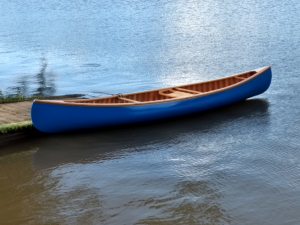
So said Bill Mason in his canoeing video “Song of the Paddle”. No doubt Mason was referring to those French-Canadian voyageurs, now long gone, who used birchbark canoes in the fur trade some 250 years ago. Bill Mason was a skilled Canadian canoeist and film maker whose films focused on wilderness tripping.
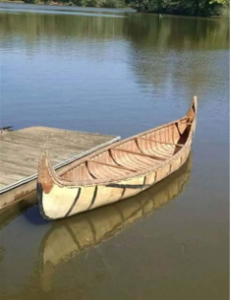
Today, canoes of various constructions and uses are displayed in museums. Three museums that come to mind are the Canadian Canoe Museum in Peterborough, Ontario: the Wisconsin Canoe Heritage Museum in Spooner, Wisconsin; and the Smithsonian in Washington, DC. The Smithsonian houses, among other canoes and artifacts, the original 20 pound Wee Lassie, built by J.H. Ruston in 1883. Such boats have much to teach those of us who love canoes. More on the Wee Lassie later.
Right after returning from a 250 mile trip on Ontario’s Trent Severn Waterway years ago, Peg and I had the good fortune to meet Tom MacKenzie, arguably America’s foremost builder of cedar-fabric canoes. What a life-changer that has been! Tom’s Loon Works canoe business actively promoted FreeStyle canoeing. In spite of having paddled many long trips, Peg and I were taken by the skill of those FreeStyle paddlers who had taught their beautiful canoes to do amazing things.
Tom offered to let us paddle his tandem canoe, the PAL. He watched us intently and offered his instructional video. He then lent us the PAL and suggested we return in a couple of weeks to show “what we had learned”. Halfway home, with his canoe tied on our roof, I said to peg, “Does that guy even know who were are?” Nope, he did not. Tom was a trusting soul. We could have kept his canoe, but had we never returned it, I might be writing a different story today.
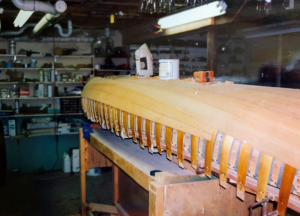
Somehow, we passed Tom’s paddling test. In fact, we paddled that borrowed boat for a full year as he helped me build our own PAL in his well-equipped shop. Tom is so recognized in the canoeing world that his shop, with several of his canoes, is now on permanent display at the Wisconsin Canoe Heritage Museum.
During the build, I had many do-overs but one stands out in my memory. Tom was the master of brush painting. He never sprayed any of his beautiful canoes. He taught me, “Slop it on, spread it out, pick it up”. He stood beside me, instructing, critiquing, scolding. “That stroke was too short!” and then “That stroke was too long!”. After sanding out coat after coat, I finally passed the test. The standards may have been lowered a bit.
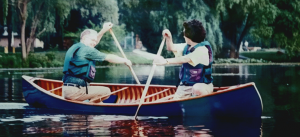
Tom introduced us to many canoeing luminaries including David Yost of DY Designs, who has designed canoes for the Loon Works, Bell, Sawyer, Swift, Curtis, and many others. We took classes from those who had developed the FreeStyle technique. Our instructors were among the best. And the best of the best paddled Tom’s Loon Works boats.
Years later, Tom and I shared a boathouse. At one time it housed as many as 27 canoes. Some were Tom’s demo boats. But it also held canoes by Mike Galt, Ted Bell, Pat Moore, Walter Walker, and many more. The oldest were two cedar Peanuts, used in sprint racing more than 100 years ago. There were canoes of birch bark, cedar-strip, cedar-fabric, fiberglass, Royalex, Kevlar, and a few Others. We paddled them all. The only construction that was never represented was the dugout.
I particularly enjoyed paddling the birchbark and cedar-fabric canoes that Tom built. As I paddled those boats I was transported back in time. I imagined myself paddling a beaver pelt-laden birchbark with Hudson Bay Company voyageurs, or perhaps joining Eric Sevareid on his epic 2000 mile canoe journey to York Factory, Manitoba.
As the song goes, the years have done irrevocable harm. I maintain that I am not getting older but instead, that my canoes are getting heavier. My favorite canoe is a beautiful Loon Works Solitaire at just twenty seven pounds, built 15 years ago by Tom. But now it had become time for me to get an even lighter canoe. This, however, presented a dilemma.
After much deliberation, I purchased a 15 pound, carbon fiber Wee Lassie from John Diller of Savage River. Savage River is known primarily for their fast racing canoes, but I prefer traditional boats. So their Wee Lassie, whose origin goes back nearly 140 years, was the obvious choice. However, it bothered me that I would now be paddling a canoe untouched by my best friend, Tom MacKenzie. Tom is gone now; he passed in 2015.
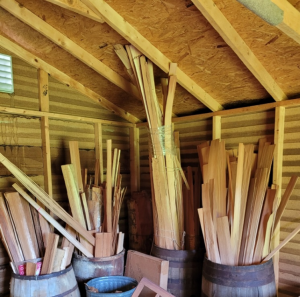
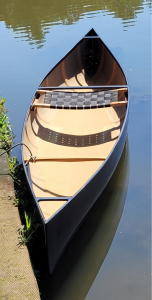
I decided to add a thwart to my new Wee Lassie. I went to Tom’s old shed where birchbark, cedar planking and ribs, spruce root lashings, and pine pitch were stored. Perhaps Tom had hoped to build just one last birchbark. Among all that hand split cedar there was just one carefully shaped cedar thwart, carved by Tom’s hands more than 40 years ago. It was the perfect length. Had he intended me to find it? Tom’s cedar thwart has now become part of my carbon fiber Wee Lassie. It seems Bill Mason was right.
“When you paddle a canoe, you travel with those who have gone before”
This article first appeared in the US Canoe Association’s CANOE NEWS journal, and is reprinted here with the gracious permission of the author and the USCA. Thank you!